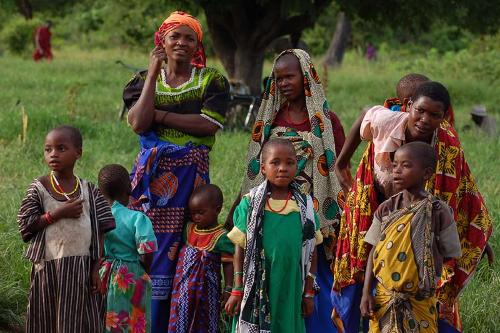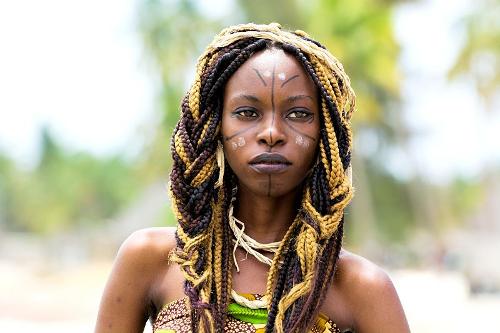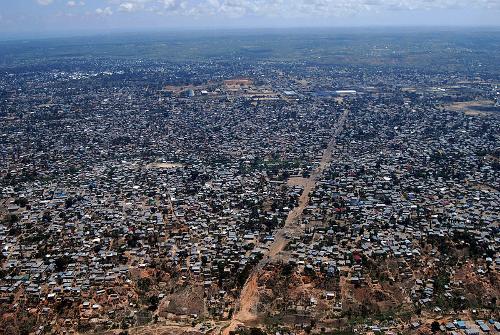TANZANIA
Population

Population
Popular destinations TANZANIA
| Pemba | Zanzibar |
Population
Structure
 Sukuma women and children, TanzaniaPhoto: Paulshaffner CC 2.0 Generic no changes made
Sukuma women and children, TanzaniaPhoto: Paulshaffner CC 2.0 Generic no changes made
The Tanzanian population consists for 99% of Africans and consists of about 120 tribes, mainly Bantu speakers, who came from West and North Africa in the distant past. The oldest group of inhabitants speak Khoisan (a so-called "click language"), a language also spoken by the Hottentots of Southern Africa. The Cushite-speaking tribes migrated to Tanzania from Ethiopia and Somalia.
The largest tribes are those of the Sukuma, Nyamwezi, Haya, Nyakyusa and Chagga with more than 1 million members each.
In addition to the African population groups, Tanzania is home to Nilots (Luo, Maasai), Arabs, Asians (mainly Indians and Pakistanis who live in Dar es Salaam and Zanzibar) and Europeans. The original population of Zanzibar consists of Hadimu, Tumbatu and Pemba.
There are no predominant contradictions between the different tribes. This is most likely because none of the tribes make up much more than 10% of the total population.
Short description of important or special tribes:
CHAGGA
The reasonably prosperous Chagga were one of the first tribes to meet Lutheran and Roman Catholic missionaries, who provided better agricultural methods. They mainly live on the southern slopes of Kilimanjaro, where they mainly grow coffee on the fertile soil.
DOROBO
The Dorobo are a Nilotic speaking hunter tribe living in the same areas as the Maasai. However, most of the tribe lives in Kenya and they are called Ndoboro there.
HA
The still very traditionally living Ha live in western Tanzania and on the northern shores of Lake Tanganyika. They are livestock keepers who are world famous for their traditional dances.
HADZAPI
The Hadzapi, who have lived in Tanzania for thousands of years, live in Northern Tanzania and are farmers and pastoralists. Closely related to the Hadzapi are the Sandawe and Hi tribe. The San tribe or Hottentots from southern Africa are also closely related to Hadzapi, who speak Khoisan, a so-called "click language". The ancestors of this tribe lived in Ethiopia.
HAYA
The Haya are farmers who also benefited greatly from the early introduction to Europeans and socially and culturally. Both coffee and banana cultivation is important to them and they are also culturally and socially highly developed.
HEHE
The Hehe are a very self-contained tribe, with strict social and cultural customs. It used to be a warlike people, nowadays some clans live from agriculture, others from cattle breeding and still others have a mixed farm.
HI
The Hi live mainly southwest of Lake Eyasi in Northern Tanzania. It is one of the smallest Tanzanian tribes and they are closely related to the Hadzapi and the Sandawe. They speak Khoisan, a "click language". The primitive people live from hunting, eat tubers and do not live in tents but live in the open air.
MAASAI ("he who speaks the language of the Maa")
Maasai are livestock farmers who migrated from North Africa, via the Nile Valley, to Tanzania in the 17th century. The largest Maasai tribe, the Ilkisongo, lives in Tanzania.
They are very striking because of their large stature and their colorful clothing.
MAKONDE
The very retired Makonde live in southeastern Tanzania and partly in Mozambique. They are among the largest tribes in Tanzania and are renowned for their beautiful carvings.
NYAMWEZI (Swahili: "people of the moon")
The Nyamwezi, sister people of the Sukuma, live in the very dry area south of Tabora on the Ugalla River. These former trading people originated from a number of Bantu tribes and now mainly grow rice, maize and sorghum.
SHIRAZI
The ancestors of this "tribe" come from the Shiraz region of Iran and eventually mixed with Bantu tribes. There is actually no longer any question of a real tribe.
SUKUMA ("people of the north")
The Sukuma, sister people of the Nyamwezi, are the largest tribe in Tanzania and make up more than 10% of the population. They mainly live south of Lake Victoria in northern Tanzania. They live from extensive livestock farming, but mainly from agriculture, and were the first to grow cotton on a large scale. They also grow sorghum, millet and maize.
SWAHILI
The Swahili are not so much a separate people as a collection of peoples in the coastal area of Tanzania.
Main concentrations of individual tribes
 Haya girl, TanzaniaPhoto: Happiness Stephen CC 4.0 International no changes
Haya girl, TanzaniaPhoto: Happiness Stephen CC 4.0 International no changes
Northern Tanzania from west to east
Nguruimi, Kuria, Ikuzu, Sweta, Isenye, Ngorome, Nyamongo, Nyabasi, Nata, Ikoma, Songo, Meru, Arusha, Chagga, Pare, Mbugu, Shamba, Bondei
Around Lake Victoria
Nyambo, Haya, Rundi, Subi, Zinza, Sukuma, Kerewe, Kara, Zanaki, Bakway, Basita
Indian Ocean coast from north to south
Digo, Zigua, Kwere, Zaramo, Rufiji, Mbwera, Matumbi, Machinga, Makombe
Central Tanzania from north to south
Sumbwa, Hadzapi, Mbugwe, Hi, Iraqw, Sukuma, Masai, Gorowa, Nyisanzu, Nyiramba, Iramba, Tatoga, Rangi, Burungi, Sandawe, Nyaturu, Gogo, Nyamwezi, Rungwa, Kaguru, Nguru, Luguru, Kutu, Sagara, Vidunda, Hehe, Kimbu, Pimbwe, Sangu, Bungu, Guruka, Nyia, Ngonde, Safwa, Mbunga, Ndamba, Bena, Ndingo
Southern border from west to east
Namwanga, Fumbo, Kukwe, Ndari, Wanji, Kinga, Nyakyusa, Kinga, Kisi, Manda, Pangwa, Ngoni, Nyasa, Matengo, Ndendehule, Ndonde, Yao, Pogoro, Makua, Mwera
West near Lake Tanganyika from north to south
Ha, Manyema, Vinza, Jiji, Baholoholo, Tonwe, Bende, Konongo, Fipa, Rungu, Mambwe
Distribution and demographics
 Dar Es Salaam, TanzaniaPhoto: BBM Explorer CC 2.0 Generic no changes made
Dar Es Salaam, TanzaniaPhoto: BBM Explorer CC 2.0 Generic no changes made
Tanzania has 70 million inhabitants in 2024 and is relatively sparsely populated with an average population density of approximately 80 inhabitants per km2.
The population distribution is very uneven. Some coastal areas and Zanzibar / Pemba are densely populated, with more than 300 inhabitants per km2.
The area around Lake Victoria also has a high population density. However, only one person per km2 lives in some arid regions.
The annual population growth was around 3% between 1985 and 2010 (2024: 2.72%).
The biggest cities are: Dar es Salaam, main port, government seat and former capital (7 million) Dodoma, Zanzibar Town, Morogoro, Mbeya, Tanga and Mwanza. Yet most people still live in rural areas, a consequence of Tanzania's tradition of being a tribal society. In 2024, 37,4% of the population lives in cities.
Population composition in 2024:
- 0-14 years 41.2%
- 15-64 years 55.4%
- 65+ 3.4%
Life expectancy in 2024:
- men 69 years
- women 72.6 years
- total population 70.8 years
Sources
Heale, J. / Tanzania
Marshall Cavendish
Tanzania
Cambium
Vlugt, B. / Kenia, Tanzania, Zanzibar
Gottmer/Becht
Waard, P. de / Reishandboek Tanzania
Elmar
CIA - World Factbook
BBC - Country Profiles
Copyright: Team The World of Info